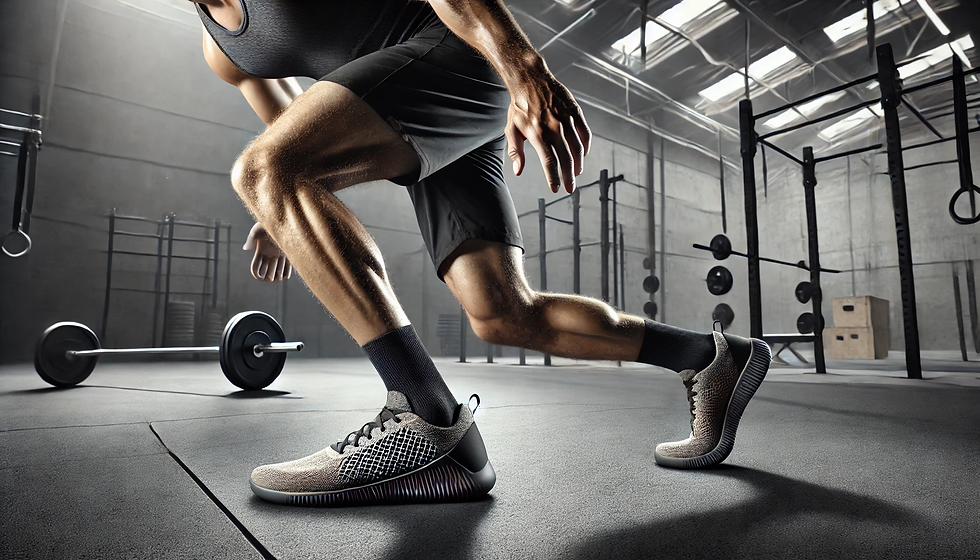Feet First: Strength, Stability, and Success Through Barefoot Training
- FitnessFirstAcademy

- Nov 28, 2024
- 4 min read

Introduction
Have you ever considered the strength and mobility of your feet? They’re the foundation for nearly every athletic movement, yet we often overlook their role in performance and injury prevention. Traditional shoes can weaken foot muscles and limit natural movement, but barefoot training offers a way to strengthen your foundation, improve balance, and move the way your body was designed to.
In this article, I’ll share how barefoot training has improved my fitness, the benefits it can offer, and how you can get started safely—with insights from top experts in the field.
The Benefits of Barefoot Training
Strengthens Foot and Ankle Muscles:
Traditional shoes often over-support your feet, leaving the muscles underused. Training barefoot forces your feet and ankles to do the work, building strength and stability over time.
Dr. Emily Splichal, a podiatrist and human movement specialist, emphasizes that “training without shoes allows the feet to engage more naturally, strengthening intrinsic muscles and enhancing overall stability.” (Hindustan Times)
Improves Balance and Proprioception:
Barefoot training enhances your body’s ability to sense and adjust to changes in position, improving coordination and athletic performance.
Deja Riley, a wellness expert and Lululemon studio trainer, explains, “Your connection to the ground allows you direct access to know where you are moving in space at all times.” (YouTube)
Encourages Natural Movement Patterns:
Barefoot training helps you move the way your body is meant to—whether it’s running, squatting, or lateral drills.
Nick Clayton, C.S.C.S., personal training program manager for the National Strength and Conditioning Association, notes that “going barefoot offers a number of benefits for balance, mobility, and coordination.” (BuiltLean)
Reduces Risk of Certain Injuries:
Weak feet and limited ankle mobility are common causes of injuries like plantar fasciitis and shin splints. Strengthening these areas can help prevent future problems.
Emanuele Calabrese, an osteopath and musculoskeletal pain expert, points out that “barefoot training can enhance any sport that involves speed, stability, and control. It strengthens the foot’s intrinsic muscles, leading to better proprioception and coordination.” (The Body Lab London)
How Barefoot Training Changed My Fitness
For years, I relied on traditional athletic shoes, but I started noticing issues with ankle mobility and stability. Transitioning to barefoot shoes wasn’t easy, but it made a real difference. My balance improved, my foot strength became noticeable, and I gained better control over my movements. Whether I’m training clients or playing soccer, barefoot shoes now feel like a key part of my routine.
This journey reminded me of soccer legend Ronaldinho’s story. He once shared, “Once my father told me to learn to control the ball with barefoot so that I can feel the ball. But the reality was, my father could not afford to buy me a pair of boots.” His father’s advice turned out to be prophetic, as Ronaldinho’s unmatched ball control became one of his defining skills on the field. This anecdote highlights how barefoot training can enhance foot sensitivity, control, and coordination—qualities essential for athletic excellence.

How to Transition to Barefoot Training Safely
Transitioning to barefoot training takes patience. Your feet need time to adjust to moving without the support they’re used to.
Start Gradually:
Begin with short, low-impact activities like walking or bodyweight exercises for 10–15 minutes a day.
Slowly increase duration and intensity as your feet adapt.
Focus on Form:
Barefoot training reveals weaknesses and imbalances. Pay close attention to proper form during exercises like squats and lunges.
Incorporate Foot-Strengthening Exercises:
Toe spreads: Spread your toes as wide as possible and hold for 5 seconds.
Short foot exercise: Press your toes into the ground while lifting your arch.
Calf raises: Strengthen your calves and support your transition.
Use Barefoot Shoes:
Minimalist shoes provide some protection while allowing your feet to move more naturally.
Listen to Your Body:
Some soreness is normal as your muscles adapt, but don’t push through sharp pain or discomfort.
Exercises to Try Barefoot
Bodyweight Squats:
Focus on proper alignment and balance as your feet grip the ground.
Deadlifts:
Barefoot deadlifts improve your connection to the floor and increase stability.
Single-Leg Balance Drills:
Enhance ankle stability and coordination.
Short Runs or Sprints:
Gradually build up to running barefoot to strengthen your arches and improve running mechanics.

Who Should Be Cautious?
Existing Foot Injuries: If you have foot injuries or conditions like plantar fasciitis, consult a professional before starting.
High-Impact Sports: Use barefoot training as a supplement rather than replacing your usual footwear, especially in sports with high-impact movements.
Conclusion
Barefoot training isn’t just a fitness trend—it’s about building a strong foundation from the ground up. As Paul Chek, a health and wellbeing expert, says, “Feet are not designed to be boxed in shoes. Allowing natural foot movement can improve posture and reduce the risk of injuries.” (Magzter)
By strengthening your feet and improving balance, barefoot training can take your performance to the next level. Start slow, stay consistent, and watch as your foundation grows stronger with every step.
References
Hindustan Times. “Do you wear shoes while working out? Experts say you are doing it wrong.” Link
YouTube. “Barefoot Training with Deja Riley.” Link
BuiltLean. “Everything You Need to Know About Barefoot Training.” Link
The Body Lab London. “Barefoot Training: What You Need to Know.” Link
Magzter. “The Benefits of Barefoot Training.” Link
Ronaldinho Quote Reference: Football Sources. “Ronaldinho’s Barefoot Story.” Link

About the Author
Alexander Morrow is a NASM Certified Personal Trainer, ACE Certified Personal Trainer, ACE Certified Group Fitness Instructor, NCSF Certified Strength & Conditioning Coach & ACE Fitness Nutrition Specialist with a passion for helping people reach their fitness goals. With a focus on strength training and functional movement, he believe in building a strong, capable body from the inside out. Connect with @FitnessFirstAcademyF1A on Instagram or visit www.FitnessFirstAcademy.com/blog for more training tips and inspiration.
Get Ready to Feel Strong and Powerful!



Comments